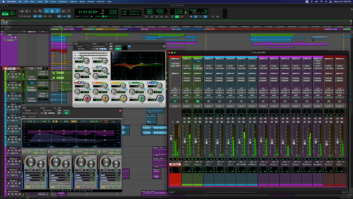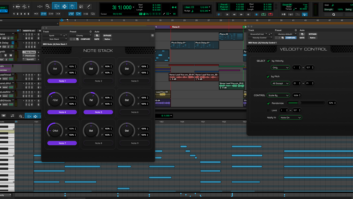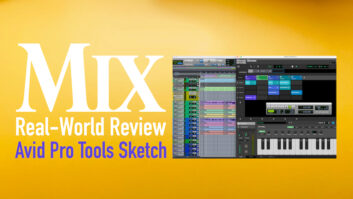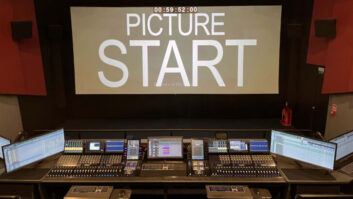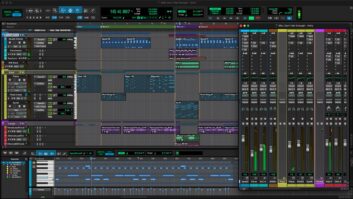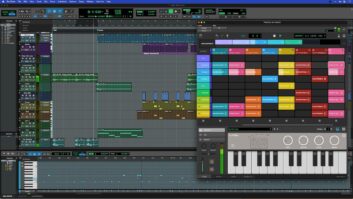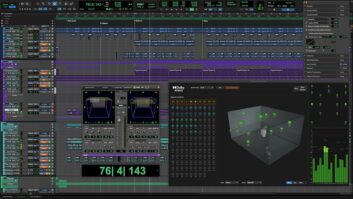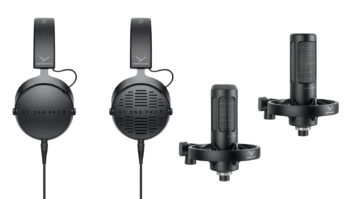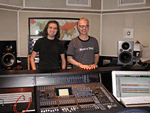
Engineer Mario McNulty (l) and Tony Visconti take a break from work on 5.1 remixes of Bowie’s Stage and David Live.
As producer, engineer and arranger on David Bowie classics The Man Who Sold the World, Diamond Dogs, Young Americans, Low, Heroes, Lodger and Scary Monsters, Tony Visconti’s contribution was a significant one, and he has been working on 5.1 remixes of selections from the Bowie catalog, including Stage and David Live. Those remixes allowed Visconti to revisit some of his early work, but and was the catalyst to update his studio at Philip Glass’ Looking Glass Studios in New York with a Yamaha DM2000 digital mixing console and MSP10 studio monitors, plus LOGIC 6.4.2 and Pro Tools 6.2 recording media.
“Conventional analog desks can be a challenge with 5.1,” explains Visconti. “Some of them don’t have the proper routing, and you’ve got to do all kinds of tricks. These projects were time-sensitive, so we needed gear that was 5.1-oriented, and digital boards seemed like the only option. Admittedly, I was hesitant. Having used all-in-one DAWs and computer-based recording, I was used to multi-menus and multi-layers, but hadn’t gone digital 100 percent on any one project.”
A visit to New York’s Right Track Studios, suggested by Visconti’s manager Joe D’Ambrosio, changed Visconti’s view on the digital audio path. “They had a new Yamaha DM2000,” says Visconti, “and when I heard it, it blew away all the myths about digital audio, like ‘it’s brittle,’ or ‘it’s cold-sounding.’ This was really intuitive and had a fat, warm sound, great EQs, real controllability, a graphic reading for everything and best of all, incredible sonic quality. We mixed Stage on it, and midway through David Live, I purchased my own.”
Visconti and his engineer, Mario McNulty, have used the DM2000 in combination with Pro Tools and LOGIC since May. “We’re using it primarily to mix, rather than control,” he says, “feeding in the Pro Tools and LOGIC channels and making all the moves on the console. We’ve also done some fixes, like flying in a guitar. The Snap, Save and Recall features have cut production time in half. For example, if you’re in a better sonic state near the end of a mix session, you can recall in Pro Tools and on the DM2000 instantly. Going from stereo to 5.1 is now like doing one mix. Fold down 5.1 doesn’t work for the simple reason that most people still listen in stereo. So for these Bowie projects, the stereo mixes happen first, and all the moves are done in automation. Mario has found a way to keep moves, EQs and scenes intact and then open it up to 5.1. We’ve discovered a lot of things as we work that aren’t in the manual.”
Visconti notes that the idea of 5.1 is to create a spatial playground. “There’s an effect in an early mix of Heroes where the lyric is ‘the guns shot above our heads,’” he explains. “In stereo, the gun shots are panned from left to right, whereas in 5.1, the sound moves from front to back, so you really get the idea of bullets passing by you. Only placing the band in the front and reverbs in the back is not using your six speakers creatively, so I’m not afraid to put primary information into the rear MSP10 speakers. What’s great about this setup and 5.1 is that you have the luxury of putting a rhythm guitar in the back right speaker, or having a full string section in the back. Classical and jazz recordings have more strict rules, but in the rock world, anything goes. After all, rock ‘n’ roll recording is basically creating an aural illusion.”
For more information on the DM2000 and MSP10 Studio, visit www.yamaha.com/proaudio.
